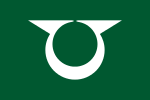Hinohara, Tokyo
Hinohara (檜原村 or 桧原村, Hinohara-mura) is a village located in the western portion of Tokyo Metropolis, Japan. As of 1 February 2016, the village had an estimated population of 2,194, and a population density of 20.8 persons per km2. Its total area is 105.41 square kilometres (40.70 sq mi). It is the only administrative unit left in the non-insular area of Tokyo that is still classified as a village.
Hinohara 檜原村 | |
|---|---|
Village | |
 Hinohara Village Hall | |
 Flag  Seal | |
 Location of Hinohara in Tokyo | |
 Hinohara | |
| Coordinates: 35°43′36.5″N 139°8′56″E | |
| Country | Japan |
| Region | Kantō |
| Prefecture | Tokyo |
| District | Nishitama |
| Area | |
| • Total | 105.41 km2 (40.70 sq mi) |
| Population (February 2016) | |
| • Total | 2,194 |
| • Density | 20.8/km2 (54/sq mi) |
| Time zone | UTC+9 (Japan Standard Time) |
| Symbols | |
| • Tree | Hinoki |
| • Flower | Kerria japonica |
| • Bird | Japanese bush-warbler |
| Phone number | 042-598-1011 |
| Address | 467-1 Hirohara-mura, Nishitama-gun, Tokyo 190-0212 |
| Website | www |
Geography
Hinohara lies in the mountainous upper reaches of the Akigawa, a tributary of the Tama River. The highest point is the summit of Mount Mitō at 1528 m. 93% of its area is forest.
The name Hinohara means the field or forest of Chamaecyparis obtusa. Formerly the trees were cut down to build wooden structures in Edo.
Motoshuku, at the confluence of the north and south branches of the Akigawa, is the center of the village and is where the village offices are located.
Mountains in Hinohara include Shōtō (990 m), Ichimichi (795 m), Kariyose (687 m), Usuki (842), and Ōdake (1267 m).
Surrounding municipalities
- Tokyo Metropolis
- Kanagawa Prefecture
- Sagamihara (to the west)
- Yamanashi Prefecture
History
The area of present-day Hinohara was part of ancient Musashi Province. In the post-Meiji Restoration cadastral reform of July 22, 1878, the area became part of Nishitama District in Kanagawa Prefecture. The village of Hinohara was created on April 1, 1889 with the establishment of municipalities law. Nishitama District was transferred to the administrative control of Tokyo Metropolis on April 1, 1893.
Politics
Hinohara has a village mayor and a village council with nine elected members. The city has 57 employees.
Economy
The principal industries of Hinohara are forestry and Sawmill because Hinohara is surrounded by mountains. These days it's not as active as it used to be, but Some young people are trying to run a new forestry company.[1] Recently, the quarrying industry has been used to mine stones from mountains. Also, many construction companies also receive public works orders.
In sunny areas on the mountain slopes, potatoes and konjaku are grown. In addition, [wasabi], mushrooms and [cyclamen] are also grown there.
In addition, Hinohara has many guest houses, inns, campsites, fishing grounds, hot springs, souvenir shops, and restaurants. These are service industries for tourists who come in search of abundant nature.
Education
The village has one elementary school and one junior high school.
Transportation
Railway
Hinohara has no passenger railway service. The main form of public transportation is bus. Scheduled bus service is available from Musashi-Itsukaichi Station on the JR East Itsukaichi Line.
Highway
Hinohara has no national expressways or national highways. Tokyo Routes 33, 205, and 206 carry vehicular traffic.
References
- 【就活ON!SPECIAL】青木亮輔 林業ベンチャー社長/切り開くのは未来『読売新聞』朝刊2018年9月4日(くらし・教育面)
External links

- Hinohara Village Official Website (in Japanese)